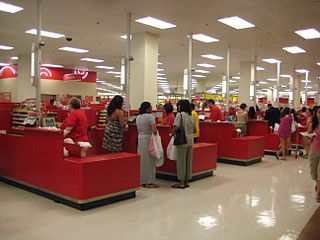Related Research Articles

The point of sale (POS) or point of purchase (POP) is the time and place at which a retail transaction is completed. At the point of sale, the merchant calculates the amount owed by the customer, indicates that amount, may prepare an invoice for the customer, and indicates the options for the customer to make payment. It is also the point at which a customer makes a payment to the merchant in exchange for goods or after provision of a service. After receiving payment, the merchant may issue a receipt for the transaction, which is usually printed but can also be dispensed with or sent electronically.
Personalized marketing, also known as one-to-one marketing or individual marketing, is a marketing strategy by which companies leverage data analysis and digital technology to deliver individualized messages and product offerings to current or prospective customers. Advancements in data collection methods, analytics, digital electronics, and digital economics, have enabled marketers to deploy more effective real-time and prolonged customer experience personalization tactics.

A captive portal is a web page accessed with a web browser that is displayed to newly connected users of a Wi-Fi or wired network before they are granted broader access to network resources. Captive portals are commonly used to present a landing or log-in page which may require authentication, payment, acceptance of an end-user license agreement, acceptable use policy, survey completion, or other valid credentials that both the host and user agree to adhere by. Captive portals are used for a broad range of mobile and pedestrian broadband services – including cable and commercially provided Wi-Fi and home hotspots. A captive portal can also be used to provide access to enterprise or residential wired networks, such as apartment houses, hotel rooms, and business centers.

A hotspot is a physical location where people can obtain Internet access, typically using Wi-Fi technology, via a wireless local-area network (WLAN) using a router connected to an Internet service provider.

Online shopping is a form of electronic commerce which allows consumers to directly buy goods or services from a seller over the Internet using a web browser or a mobile app. Consumers find a product of interest by visiting the website of the retailer directly or by searching among alternative vendors using a shopping search engine, which displays the same product's availability and pricing at different e-retailers. As of 2020, customers can shop online using a range of different computers and devices, including desktop computers, laptops, tablet computers and smartphones.
In computing, Internet geolocation is software capable of deducing the geographic position of a device connected to the Internet. For example, the device's IP address can be used to determine the country, city, or ZIP code, determining its geographical location. Other methods include examination of Wi-Fi hotspots, a MAC address, image metadata, or credit card information.
Bluesnarfing is the unauthorized access of information from a wireless device through a Bluetooth connection, often between phones, desktops, laptops, and PDAs. This allows access to calendars, contact lists, emails and text messages, and on some phones, users can copy pictures and private videos. Both Bluesnarfing and Bluejacking exploit others' Bluetooth connections without their knowledge. While Bluejacking is essentially harmless as it only transmits data to the target device, Bluesnarfing is the theft of information from the target device.

Digital signage is a segment of electronic signage. Digital displays use technologies such as LCD, LED, projection and e-paper to display digital images, video, web pages, weather data, restaurant menus, or text. They can be found in public spaces, transportation systems, museums, stadiums, retail stores, hotels, restaurants and corporate buildings etc., to provide wayfinding, exhibitions, marketing and outdoor advertising. They are used as a network of electronic displays that are centrally managed and individually addressable for the display of text, animated or video messages for advertising, information, entertainment and merchandising to targeted audiences.
The term mobile commerce was originally coined in 1997 by Kevin Duffey at the launch of the Global Mobile Commerce Forum, to mean "the delivery of electronic commerce capabilities directly into the consumer’s hand, anywhere, via wireless technology." Many choose to think of Mobile Commerce as meaning "a retail outlet in your customer’s pocket."
Proximity marketing is the localized wireless distribution of advertising content associated with a particular place. Transmissions can be received by individuals in that location who wish to receive them and have the necessary equipment to do so.
A people counter is an electronic device that is used to measure the number of people traversing a certain passage or entrance. Examples include simple manual clickers, smart-flooring technologies, infrared beams, thermal imaging systems, WiFi trackers and video counters using advanced machine learning algorithms. They are commonly used by retail establishments to judge the effectiveness of marketing campaigns, building design and layout, and the popularity of particular brands.
Customer analytics is a process by which data from customer behavior is used to help make key business decisions via market segmentation and predictive analytics. This information is used by businesses for direct marketing, site selection, and customer relationship management. Marketing provides services in order to satisfy customers. With that in mind, the productive system is considered from its beginning at the production level, to the end of the cycle at the consumer. Customer analytics plays an important role in the prediction of customer behavior.
Omnichannel is a neologism describing a business strategy. According to Frost & Sullivan, omnichannel is defined as "seamless and effortless, high-quality customer experiences that occur within and between contact channels".
Carrier IQ was a privately owned mobile software company founded in 2005 in Sunnyvale, California. It provided diagnostic analysis of smartphones to the wireless industry via the installation of software on the user's phone, typically in a manner that cannot be removed without rooting the phone. The company says that its software is deployed in over 150 million devices worldwide.

Shopkick is an American company based in Denver that created a shopping app for smartphones and tablets offering users’ rewards for shopping activities on both online and offline platforms such as walking into stores, scanning items, making in-app or in-store purchases and submitting receipts. Users are awarded "kicks" for these actions, and can exchange them for rewards in the form of mobile gift cards. The app is currently available for iOS and Android devices.
Merchant Customer Exchange (MCX) was a company created by a consortium of U.S. retail companies to develop a merchant-owned mobile payment system, which was to be called "CurrentC." The joint venture was announced on August 15, 2012.
iSIGN Media (iSIGN) is a proximity marketing company headquartered in Richmond Hill, Ontario, with R&D and customer support operations in Vancouver, British Columbia and Tampa, Florida. The company uses Bluetooth, mobile, WiFi and location-aware technologies to deliver rich-media, permission-based messages at designated locations or at events, such as Super Bowl XLVII. The company installs smart antenna technology to enable customers to deliver commercial offers while protecting consumer privacy.
Behavioral analytics is a recent advancement in business analytics that reveals new insights into the behavior of consumers on eCommerce platforms, online games, web and mobile applications, and Internet of Things (IoT). The rapid increase in the volume of raw event data generated by the digital world enables methods that go beyond demographics and other traditional metrics that tell us what kind of people took what actions in the past. Behavioral analysis focuses on understanding how consumers act and why, enabling predictions about how they are likely to act in the future. It enables marketers to make the right offers to consumer segments at the right time.
iBeacon is a protocol developed by Apple and introduced at the Apple Worldwide Developers Conference in 2013. Various vendors have since made iBeacon-compatible hardware transmitters – typically called beacons – a class of Bluetooth Low Energy (BLE) devices that broadcast their identifier to nearby portable electronic devices. The technology enables smartphones, tablets and other devices to perform actions when in proximity to an iBeacon.

Purple is a UK-based technology firm that specializes in intelligent spaces. The company offers a three core products guest WiFi, business analytics and digital wayfinding.
References
- ↑ "Mobile Location Analytics Code of Conduct" (PDF). Futureofprivacy.org. Retrieved 14 October 2014.
- ↑ Office of the Privacy Commissioner of Canada 2016.
- ↑ Dachwitz, Ingo (2018-02-20). "Endlich auch offline verfügbar: Gläserne Kunden". netzpolitik.org (in German). Retrieved 2019-06-24.
- ↑ "Location Analytic s: The Future is Where". Insights.wired.com. Retrieved 15 October 2014.
- ↑ Synqera. "U.S. Retail Survey Reveals 93% of U.S. Consumers Are Loyal to Brick and Mortar Retailers Who Have Sales on Frequently Purchased Items". www.prnewswire.com (Press release). Retrieved 2020-12-08.
- ↑ "AugustCapital". Augustcaptial.typepad.com. Retrieved 15 October 2014.
- ↑ "The Retail Industry and Mobile Device Tracking - Online Marketing Intelligence, Web Analytic s, Privacy - Evident". Evident.com. Retrieved 15 October 2014.
- ↑ "What is mobile location analytics (MLA)? - Definition from WhatIs.com". SearchBusinessAnalytics. Retrieved 2021-04-01.